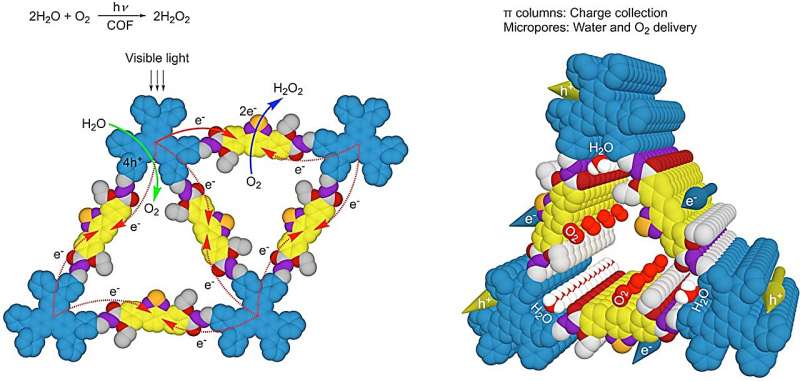This article has been reviewed according to Science X's editorial process and policies. Editors have highlighted the following attributes while ensuring the content's credibility:
fact-checked
trusted source
proofread
Researchers develop novel method to photosynthesize hydrogen peroxide using water and air

Researchers at the National University of Singapore (NUS) have developed a microporous covalent organic framework with dense donor–acceptor lattices and engineered linkages for the efficient and clean production of hydrogen peroxide (H2O2) through the photosynthesis process with water and air.
Traditional industrial production of H2O2 via the anthraquinone process using hydrogen and oxygen is highly energy-intensive. This approach employs toxic solvents and expensive noble-metal catalysts and generates substantial waste from side reactions.
In contrast, photocatalytic production of H2O2 from oxygen and water offers an energy-efficient, mild, and clean route. Most importantly, it addresses the common drawbacks of existing photocatalytic systems, such as low activity, heavy use of additional alcohol sacrificial donors, and the necessity for pure oxygen gas input.
A research team led by Professor Jiang Donglin from the NUS Department of Chemistry has developed a new type of photocatalyst for the efficient artificial photosynthesis of H2O2 from water and air. The researchers constructed hexavalent covalent organic frameworks (COFs) in which the skeleton is designed to be donor-acceptor π columns for high-rate photo-induced charge generation and catalytic active sites.
In parallel, the pore is engineered with hydraulically sensitive trigonal microporous channels for immediate delivery of reactants water and oxygen. As a result, these hexavalent COFs produce H2O2 spontaneously and efficiently from water and atmospheric air when exposed to visible light in both batch and flow reactors.
Under laboratory conditions, the COFs demonstrate a quantum efficiency of 17.5 percent under visible light at 420 nm in batch reactors. This system can be developed to construct self-cleaning surfaces and for disinfection treatments.
The research findings were published in Nature Catalysis.
Prof Jiang said, "In this work, we successfully addressed a key and common issue in photocatalysts, electrocatalysts, and heterogeneous catalysts, which is the efficient supply of charges and mass to catalytic sites. Our focus on precise structural design at the atomic level to explore both the skeletons and pores of COFs has led to the creation of an artificial photosynthesis system for H2O2 production, achieving unprecedented photocatalytic efficiency."
More information: Ruoyang Liu et al, Linkage-engineered donor–acceptor covalent organic frameworks for optimal photosynthesis of hydrogen peroxide from water and air, Nature Catalysis (2024). DOI: 10.1038/s41929-023-01102-3
Provided by National University of Singapore





















